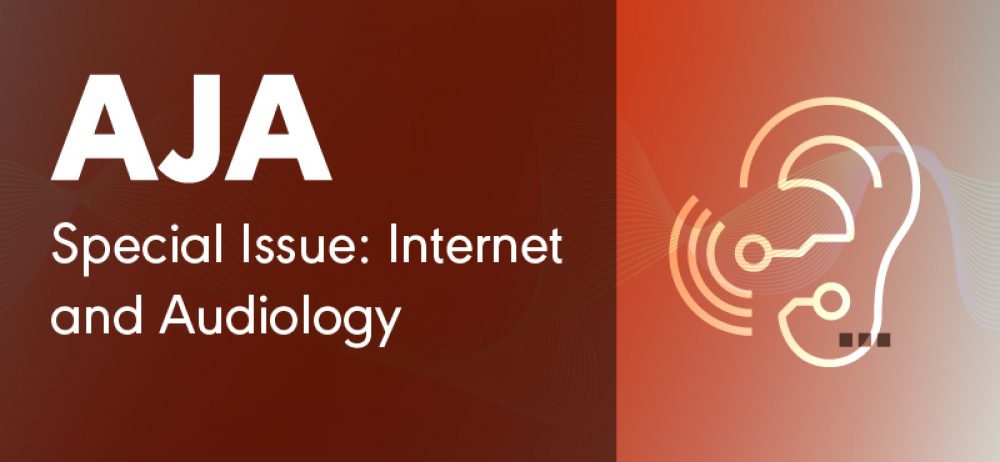During the 4th International Meeting on Internet and Audiology last June, the attendees had no idea just how quickly their research would be put into widespread practice. In the latest special issue from the American Journal of Audiology (AJA), Guest Editors Gabrielle H. Saunders and Jill E. Preminger present 12 papers from last year’s meeting. In their introduction, they write that 98% of audiologists in the United Kingdom have had at least one virtual appointment since the onset of the COVID-19 pandemic, and 84% say they will continue to do so (Saunders & Preminger, 2020), making this special issue particularly relevant for audiologists across the globe.
Four articles in this special issue focus on teleaudiology methodologies. Paglialonga and colleagues (2020) describe an automated speech-in-noise test for use in remote screening that is intended to work regardless of the listener’s language. Shafiro and colleagues (2020) discuss a similar remote test of basic auditory skills of users with cochlear implants; already this study is showing encouraging findings. In another article, Schinkel-Bielefeld and colleagues (2020) examine ecological momentary assessment (EMA) to assess hearing aid outcomes, examining whether or not listening situations are missed during evaluations due to situational factors. In the fourth article on teleaudiology, Lund and colleagues (2020) describe a novel tool that they’ve designed to reveal additional insights into how hearing aids are working for a patient whose communication disorder may not be captured in a standard questionnaire.
Three additional articles discuss Internet- or app-based self-management options that audiologists can explore with their patients. In their article, Burden and colleagues (2020) discuss the design of a program to motivate adults with untreated hearing loss to seek treatment, including input from potential patients. Patient input was also the focus of an article by Meijerink and colleagues (2020), who discuss the development of a support program for hearing aid users who are older—and how participant feedback shaped and sculpted the program. Later, Pronk and colleagues (2020) discuss an app under development that will offer information promoting self-awareness and improving communication tailored to a person’s acoustic environment.
Additional aspects of service provision are covered in three other articles. Smith et al. looked at 15 noncommercial websites that provided resources for hypercusis, finding large disparities in the quality of the content. Dispensers and audiologists often log hearing aid data for the purposes of counseling clients and troubleshooting; however, Saunders and colleagues (2020) suggest that we can use this same data to diagnose hearing aid malfunction or to send alerts when a product isn’t being used. Then, Coco and colleagues (2020) look at the particular roles that patient-site facilitators play in teleaudiology service delivery.
Two additional articles bookend the special issue. A tutorial by Convery and colleagues (2020) opens the issue, looking at human–technology interaction and how audiologists can tailor the usability of a productit to a particular client. In the final article, Dillard et al. (2020) examine electronic health records, which provide many advantages for audiologists but which must be interpreted with care.
We hope you enjoy this timely issue of AJA. We would like to thank Drs. Saunders and Preminger for their diligent work putting together this special issue. You can check the full issue here or explore the individual articles below.
Explore the Issue
Burden, R. S., Galloway, L. N., Rothpletz, A. M., Glasheen, K. A., & Preminger, J. E. (2020). The development of an Internet-based decision coaching guide to encourage audiology care: The results of a participatory design approach. American Journal of Audiology, 29(3S), 546–563. https://doi.org/10.1044/2020_AJA-19-00066
Coco, L., Davidson, A., & Marrone, N. (2020). The role of patient-site facilitators in teleaudiology: A scoping review. American Journal of Audiology, 29(3S), 661–675. https://doi.org/10.1044/2020_AJA-19-00070
Convery, E., Heeris, J., Ferguson, M., & Edwards, B. (2020). Human–technology interaction considerations in hearing health care: An introduction for audiologists. American Journal of Audiology, 29(3S), 538–545. https://doi.org/10.1044/2020_AJA-19-00068
Dillard, L. K., Saunders, G. H., Zobay, O., & Naylor, G. (2020). Insights into conducting audiological research with clinical databases. American Journal of Audiology, 29(3S), 676–681. https://doi.org/10.1044/2020_AJA-19-00067
Lund, K., Ordoñez, R., Nielsen, J. B., & Hammershøi, D. (2020). Sentence-based experience logging in new hearing aid users. American Journal of Audiology, 29(3S), 631–637. https://doi.org/10.1044/2020_AJA-19-00077
Meijerink, J. F. J., Pronk, M., & Kramer, S. E. (2020). Experiences with and lessons learned from developing, implementing, and evaluating a support program for older hearing aid users and their communication partners in the hearing aid dispensing setting. American Journal of Audiology, 29(3S), 638–647. https://doi.org/10.1044/2020_AJA-19-00072
Paglialonga, A., Polo, E. M., Zanet, M., Rocco, G., van Waterschoot, T., & Barbieri, R. (2020). An automated speech-in-noise test for remote testing: Development and preliminary evaluation. American Journal of Audiology, 29(3S), 564–576. https://doi.org/10.1044/2020_AJA-19-00071
Pronk, M., Besser, J., Smits, C., Feenstra-Kikken, V., van Beek, H., Polleunis, C., & Kramer, S. E. (2020). Rationale, theoretical underpinnings, and design of HEAR-aware: Providing adults with hearing loss with tailored support to self-manage their hearing problems via a smartphone app, as an alternative to hearing aids. American Journal of Audiology, 29(3S), 648–660. https://doi.org/10.1044/2020_AJA-19-00079
Saunders, G. H., & Preminger, J. E. (2020). Introduction for the 4th International Meeting on Internet and Audiology special issue of the American Journal of Audiology. American Journal of Audiology, 29(3S), 535–537. https://doi.org/10.1044/2020_AJA-20-00101
Saunders, G. H., Bott, A., & Tietz, L. H. B. (2020). Hearing care providers’ perspectives on the utility of datalogging information. American Journal of Audiology, 29(3S), 610–622. https://doi.org/10.1044/2020_AJA-19-00089
Schinkel-Bielefeld, N., Kunz, P., Zutz, A., & Buder, B. (2020). Evaluation of hearing aids in everyday life using ecological momentary assessment: What situations are we missing?. American Journal of Audiology, 29(3S), 591–609. https://doi.org/10.1044/2020_AJA-19-00075
Shafiro, V., Hebb, M. M., Walker, C., Oh, J. J., Hsiao, Y., Brown, K. B., Sheft, S., Li, Y., Vasil, K., & Moberly, A. C. (2020). Development of the basic auditory skills evaluation battery for online testing of cochlear implant listeners. American Journal of Audiology, 29(3S), 577–590. https://doi.org/10.1044/2020_AJA-19-00083
Smith, S. N., Smallwood, E., Sereda, M., Adams, B., & Hoare, D. J. (2020). The content and quality of information about hyperacusis presented online. American Journal of Audiology, 29(3S), 623–630. https://doi.org/10.1044/2020_AJA-19-00074









